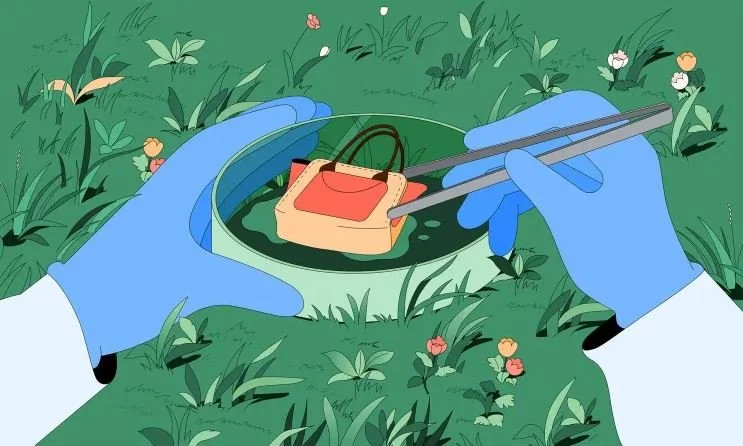Why Bio-Leather is Just What the Fashion Industry Needs
Your next pair of leather shoes or belt could very well be made in the lab, all without sacrificing a single animal.
In an era of increased environmental awareness, the fashion industry finds itself at crossroads, grappling with the need to redefine its practices to better align with a more sustainable future. The use of animal leather in fashion goods, especially those from the luxury sector, have always made animal and sustainability activists cry foul. The answer to the industry’s dilemma seems to be the innovation of bio-leather, a game-changing alternative to traditional animal leather.
In this article, we will shine a light on the significance of bio-leather in fashion, and how it could shape the future of this dynamic industry. Read on!
Bio-leather, a.k.a lab-grown leather or synthetic leather, has emerged as a revolutionary force in the fashion industry, capturing the imagination of designers, consumers, and sustainability advocates alike. Unlike traditional animal-based leather, bio-leather is a lab-grown alternative that blurs the line between style and ethics. It addresses some of the most pressing sustainability issues while providing the luxurious feel, durability, and versatility of conventional leather.
The Issues with Animal Leather
Traditional leather production has long been criticized due to environmental and ethical concerns. To obtain leather from animal hides, the industry relies on vast amounts of resources and involves processes that exact a heavy toll on the planet. Here's a closer look at the environmental and ethical challenges associated with traditional leather:
Deforestation and Land Use: The demand for leather has driven deforestation, particularly in regions like the Amazon rainforest. The need for expansive stretch of land to raise cattle contributes to this issue. As vast areas of forests are cleared to make way for livestock, biodiversity is threatened, and ecosystems are disrupted.
Greenhouse Gas Emissions: Livestock farming, a core element of leather production, is a major contributor to greenhouse gas emissions, particularly methane. These emissions exacerbate climate change, a global challenge that demands immediate attention.
Massive Water Consumption: The leather industry consumes staggering amounts of water in various stages of production, including raising animals and processing hides. This puts enormous pressure on already stressed water resources, leading to water scarcity issues in many regions.
Animal Welfare: Perhaps one of the most saddening ethical concerns, traditional leather production involves the raising and slaughtering of animals for their hides. The conditions in which these animals are kept and their treatment during the slaughtering process have raised widespread ethical questions and prompted calls for more humane alternatives.
Chemical Pollution: Leather processing often requires the use of harmful chemicals, such as chromium, which can contaminate water sources and pose health risks to workers in tanneries.
The Significance of Bio-Leather
Alternative leather made from mushrooms, pineapple leaves, and fruits, are just some of the game-changing innovations hogging the spotlight in the sustainable fashion scene, and for good reasons. These eco-friendly materials have gained significant attention within the fashion industry due to their remarkable properties, and potential to reshape the way we view and produce clothing. The reception of these bio-leathers within the fashion industry has been largely positive. Consequently, fashion designers and brands are increasingly incorporating bio-leather into their collections.
Here are the advantages bio-leather has over animal-based leather:
Sustainability: Traditional leather production often results in significant material waste due to natural imperfections. Bio-leather eliminates this issue, minimizing waste and maximizing resource efficiency. Thus resulting in lower greenhouse gas emissions, reduced water usage, and minimal land impact. This makes it a compelling choice for brands looking to adopt more sustainable practices.
Customization: Lab-grown leather allows for precise control over the material's properties, such as thickness, texture, and color. This level of customization enables designers to experiment with new aesthetics and create unique products, setting them apart in a competitive market. Designers have the flexibility to create unique textures, colors, and patterns with bio-leather, fostering creativity and innovation in fashion design.
Consistency & Quality Control: Unlike animal leather, bio-leather offers consistent quality and texture. It is free from natural imperfections, which can lead to material waste during production. This consistency enhances the efficiency of the manufacturing process and reduces waste. Bio-leather production allows for precise control over the material's characteristics. This consistency ensures a higher quality product with fewer defects than animal leather.
Durability: Bio-leather has the potential to be as durable as traditional leather, providing consumers with long-lasting, high-quality products. This durability ensures that fashion items made from bio-leather have a longer lifespan, reducing the need for frequent replacements.
Reduced Environmental Impact: The production of traditional leather is one of the leading causes of deforestation and contributes to greenhouse gas emissions. Bio-leather can be produced in closed-loop systems, greatly reducing its environmental impact.
Cruelty-Free: The most glaring advantage of bio-leather is its cruelty-free nature. It eliminates the need to raise and slaughter animals for their hides, addressing a significant ethical concern in the fashion industry.
How Bio-Leather Could Shape the Future of Fashion
Sustainability is bound to become the new industry standard as consumer awareness continues to rise. Collaboration between researchers, designers, and clothing brands is necessary to bring about this transition towards bio-leather, encouraging an interdisciplinary approach that promises more advancements in sustainable materials.
However, this transformation also hinges on robust consumer education efforts, as brands will need to transparently communicate the benefits of bio-leather to empower customers to make informed, sustainable choices.
As fashion brands increasingly adopt bio-leather, it will shape the industry's future by reducing its environmental footprint, driving innovation, and meeting the demands of an ethically conscious market. The fashion industry has the power to drive positive change through bio-leather, taking one big step in our journey towards a more sustainable and responsible fashion landscape.
Bio-leather is not merely a trend; it's a transformative force that has the potential to redefine fashion as we know it, infusing it with sustainability, ethics, and a bold vision for the future.
At 4tify we are always driven to move the needle on making fashion sustainable, by coming up with innovative solutions that could help you and your business. Talk to us about your needs, or schedule a call with our experts and we’ll figure it out!







